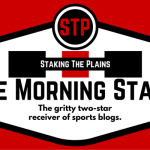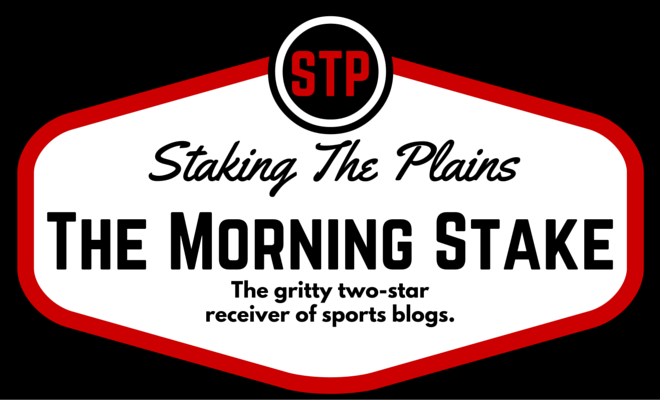On the Diamond
 Softball fell to Texas in the Big 12 Tournament and their fate was to be determined on Sunday as to whether or not they would make the NCAA Tournament. They did not, topping out at 29 wins wasn’t enough to make the tournament and I believe that the program and student-athletes were very disappointed and they felt like they had a good argument to make the tournament.
Softball fell to Texas in the Big 12 Tournament and their fate was to be determined on Sunday as to whether or not they would make the NCAA Tournament. They did not, topping out at 29 wins wasn’t enough to make the tournament and I believe that the program and student-athletes were very disappointed and they felt like they had a good argument to make the tournament.
 Baseball’s season is not yet over despite Sunday’s game against Oklahoma State being canceled. Texas Tech dropped the first two games and with some wins and losses between other Big 12 teams, Texas Tech ended up making the Big 12 Tournament. I don’t know that this will make a difference in terms of this team making the NCAA Tournament other than winning the Big 12 Tournament. This team has lost 8 Big 12 games in a row, they are in a bad way. This season is pretty well over.
Baseball’s season is not yet over despite Sunday’s game against Oklahoma State being canceled. Texas Tech dropped the first two games and with some wins and losses between other Big 12 teams, Texas Tech ended up making the Big 12 Tournament. I don’t know that this will make a difference in terms of this team making the NCAA Tournament other than winning the Big 12 Tournament. This team has lost 8 Big 12 games in a row, they are in a bad way. This season is pretty well over.
On the Court
 A busy week off the court. The winds are blowing and it appears that JT Toppin is set to go to Texas and I don’t know how much Texas Tech had a chance with Toppin even though the connections were there.
A busy week off the court. The winds are blowing and it appears that JT Toppin is set to go to Texas and I don’t know how much Texas Tech had a chance with Toppin even though the connections were there.
Then it was announced yesterday that Texas Tech target Great Osobor is set to sign with Washington for upwards of $2 million, which was obviously too rich for Texas Tech’s blood. I get the idea is that money is ruining college basketball and then there’s the part of me that thinks that this is the absolute definition of capitalism. I am sure there will be some changes (see below), but this is the business that we’re in.
Finally, UNC Wilmington forward Trazarien White is set to decide between TCU and Texas Tech and the lean is that TCU is the choice here.
 The Lady Raiders announced the signing of Sara Sanogo (6’4″) from Odessa College, averaging 11.3 points and 6.1 boards a game last year.
The Lady Raiders announced the signing of Sara Sanogo (6’4″) from Odessa College, averaging 11.3 points and 6.1 boards a game last year.
ᴛʜᴇ ʟᴀꜱᴛ ᴘɪᴇᴄᴇ ᴏꜰ ᴛʜᴇ ᴘᴜᴢᴢʟᴇ ɪꜱ ɪɴ ᴘʟᴀᴄᴇ 🧩
Let’s ✨ 𝑜𝒻𝒻𝒾𝒸𝒾𝒶𝓁𝓁𝓎 ✨ welcome, Sara Sanogo, to the Lady Raider family! #WreckEm pic.twitter.com/z23c2wBNHt
— Lady Raider Basketball (@LadyRaiderWBB) May 13, 2024
 Wyoming head coach Jeff Linder says goodbye to Wyoming and changes his X/Twitter handle to a double-T and it would seem the writing is on the wall for an announcement to Texas Tech soon.
Wyoming head coach Jeff Linder says goodbye to Wyoming and changes his X/Twitter handle to a double-T and it would seem the writing is on the wall for an announcement to Texas Tech soon.
— Jeff Linder (@jefflinder) May 13, 2024
On the Gridiron
 Lubbock Avalanche-Journal’s Don Williams on the story of Micah Hudson getting the No. 1 jersey, which not only was No. 1 up for grabs, but also No. 6:
Lubbock Avalanche-Journal’s Don Williams on the story of Micah Hudson getting the No. 1 jersey, which not only was No. 1 up for grabs, but also No. 6:
“He’s better than all four of them,” McGuire said. “I coached all four of them in high school, and what I’ve seen that guy do, I’ve really not seen many kids do what he can do. And then also truly believe it. There’s no doubt in his mind who he is.”
One other single-digit number is currently open and a source of behind-the-scenes lobbying. Defensive end Myles Cole, his eligibility done, left No. 6 available on defense. McGuire said linebacker John Curry wants it.
Get in line, McGuire thought. So do linebackers Justin Horne and Mike Dingle and cornerback Macho Stevenson. They’ll compete for it this summer.
“Let’s just say I put somebody in 6,” McGuire said. “Three of the four would have been arguing: ‘I should have gotten 6.’ There’s not anybody that argues Micah Hudson (getting No. 1). As much as I believe in him, his team … . If you ask Behren Morton, he would tell you, ‘This dude is different.’ Just the way he carries himself, everything.”
 Yahoo’s Ross Dellenger with the latest on a possible NCAA settlement and a huge cost for college athletics:
Yahoo’s Ross Dellenger with the latest on a possible NCAA settlement and a huge cost for college athletics:
At the end of it all is a steep price tag — as much as $30 million annually per school over the 10-year settlement agreement. That figure assumes a school meets what is believed to be (1) a revenue-distribution cap starting at as much as $22 million; (2) at least $2 million in withheld NCAA distribution for back damages; and (3) as much as $10 million in additional scholarship costs related to an expansion of sport-specific roster sizes.
That cost could rise significantly.
As reported earlier this month, the cap will fluctuate over the course of the settlement with increases in athletic department revenues. The cap is roughly 22% of an average of power conference school revenue streams, as detailed in this story from Yahoo Sports.
The settlement-related revenue-share concept is expected to feature some exemptions, such as counting toward the Alston-related payments to athletes. Schools providing the full Alston payment to each athlete (roughly $6,000) normally spend $1.5-$3 million annually.
As part of the new model, officials plan to lift scholarship limitations and implement roster limits, permitting schools to offer scholarships to an entire roster — a concept to prevent future litigation and one explored in detail in a story last week at Yahoo Sports. A portion of any additional scholarship is expected to also count in the cap calculations.
For many school administrators, sticker shock exists. The $30 million price tag, a startling figure for an industry that has only provided athletes with mostly non-cash resources, is about 20% of the average athletic department budget of public schools in the ACC, Big Ten, SEC and Big 12.
However, without a settlement, college leaders risk another loss in court that could triple the damages tab and leave them open to other active antitrust cases.









